Communication is the lifeline of human interaction. It connects us, shapes us, and drives our collective success.
Mastering communication is no easy task, but improving our communication skills is essential for both our personal and professional lives. Good communication can be the difference between achieving shared goals and stumbling over simple misunderstandings.
In this guide, we’ll explore:
- What communication skills are and which ones are our top 11 picks,
- What are the types of communication skills you should improve,
- What makes communication good,
- How you can communicate effectively in the workplace,
- How you can improve your communication in the workplace, and
- Why communication skills are important.
We’ve also added examples of successful communication to better illustrate good communication skills.
Let’s dive in!

What are communication skills?
The basic communication skills definition is:
Communication skills (or communicative skills) encompass a diverse set of abilities that enable an individual to effectively exchange information, ideas, and emotions with others.
Good communicators can:
- Convey information without errors or misinterpretation,
- Communicate with people with different backgrounds, views, and experiences,
- Communicate in different ways according to the given situation, and
- Present themselves in the best light.
In the workplace, communication skills are essential to facilitate smooth operations, foster a positive work environment, and drive overall success.
Being skilled at communicating with team members is vital in the workplace because it:
- Fosters collaboration,
- Builds relationships,
- Improves productivity and well-being, and
- Increases employee wellness and satisfaction.
Great communication skills are one of the most commonly requested skills in job listings. The importance of good communication is evident, and honing our communication skills is beneficial in many ways.
Now, let’s get into specific skills that you need to work on to be a good communicator.
Top 11 communication skill examples
The definitive answer to the question, “How to be good at communication?” is — work on your communication skills!
But, which ones?
Here are the top 11 communication skill examples that will help you improve your communication. These skills will help you thrive in the workplace and always put your best foot forward.
Communication skill #1: Active listening
Active listening is a vital communication skill that goes beyond just being quiet while the other person is talking. Active listening involves:
- Fully engaging with the other person,
- Paying attention to verbal and nonverbal cues,
- Making an effort to understand their point of view, and
- Formulating appropriate and engaging responses.
Our contributor, Kristie Stocker, a keynote speaker, leadership consultant, and success coach, believes that listening is the most important skill we should have:

“In my opinion, this is the #1 communication tool. If more people listened, we’d have less confusion, misunderstanding, hurt feelings, productivity issues, turnover and more happy employees, loyal clients, larger profits, and positive change.
To note, listening doesn’t mean staying quiet while the other person is talking, and then jumping in as soon as they’re done. Listening means actually digesting what they’re saying, pondering it, and asking questions for more understanding.”
If you want to be a better listener, here’s what you should do:
- Face the speaker and maintain eye contact,
- Look out for nonverbal cues,
- Listen without jumping to conclusions, and
- Stay focused on the conversation.
On the other hand, here’s what you should avoid if you want to be a good listener:
- Don’t interrupt,
- Don’t think about what you’re going to say next,
- Don’t impose your own opinions or solutions, and
- Don’t give in to distractions.
Our contributor, Chuck Wisner, an author and leadership advisor, agrees that active listening is essential for good communication:

“An important component of good communication is deep listening. This requires us to practice putting aside our strong opinions and judgments so we can absorb other perspectives. When our ego identifies with our thoughts or judgments, our mind is busy preparing our next retort. Attachment to our opinions is a significant barrier to mindful listening.”
🎓 Pumble Pro Tip
Active listening is a valuable skill for good workplace communication. If you want to become a better listener, check out our guide:
Communication skill #2: Nonverbal communication
Our body language, facial expressions, and gestures often say more than words. With that in mind, understanding and controlling our nonverbal cues should be a skill we are constantly improving.
Your nonverbal cues should always support your verbal message.
If your nonverbal signals are in accordance with your verbal communication, people are more likely to trust you. On the other hand, if your nonverbal cues don’t match up with your words, it can harm your relationships and lead to a lack of trust.
For example, you probably won’t be taken seriously if you fidget with your hands and look away from the person you’re speaking to while trying to sound persuasive. The other person may even think you’re manipulating them or trying to hide something.
Furthermore, knowing how to read nonverbal cues is just as important as being able to control your own. For example, if you’re talking to a teammate who’s bad at confrontation, their body language can tell you they’re uncomfortable. You can then change your attitude and approach them in a different way.
Nonverbal communication is a big part of communication, and you should pay attention to your own and others’ nonverbal cues to be a better communicator.
Communication skill #3: Feedback
Feedback, more specifically constructive feedback, is vital if we want to improve. Being open to feedback and constructive criticism gives us a chance to see our strengths and weaknesses and work on ourselves.
Our contributor, Smita Das Jain, an executive coach, TEDx speaker, and personal empowerment life coach, says that feedback is crucial for growth:

“Providing feedback and constructive criticism in a respectful and constructive manner is crucial for growth and improvement. Focus on specific behaviors or actions and offer suggestions for improvement.”
Therefore, don’t be afraid to ask for feedback and be prepared to give feedback to others.
Communication skill #4: Confidence
Having confidence shows that you are sure about your opinions and actions. Confident people believe in themselves and don’t doubt their decisions. This makes them feel better about themselves and, ultimately, perform better in the workplace.
Confidence is a soft skill that can be improved. The saying “Fake it ‘till you make it” definitely applies to confidence, according to studies.
Kristie Stocker also believes that it all starts with your mindset:

“Practice makes awesome. If you feel you’re not the best communicator, well, it starts with you. Create the mindset that you’re a clear, confident communicator so your brain can act accordingly. The more belief you have in yourself to communicate clearly, the better you become.”
Communication skill #5: Honesty
You should incorporate honesty into every aspect of your professional life.
Honest communication fosters a positive work environment. It builds trust among team members and enables them to do their best work.
To encourage honesty and transparency in your team, you should:
- Make important information — such as company policies, contact information, and office rules — accessible to everyone,
- Inform employees of changes and updates regularly,
- Communicate common goals, and
- Admit mistakes or wrong decisions to encourage responsibility.
At an individual level, make sure to always stay true to your views and opinions and share them in an honest and professional manner.
🎓 Pumble Pro Tip
To learn more about why transparency is essential in the workplace, check out our blog post:
Communication skill #6: Clarity
Clarity is a vital component of communication in the workplace. Clarity involves the ability to articulate thoughts, ideas, and instructions in a simple and comprehensible manner.
When communication lacks clarity, it can lead to misunderstandings and errors.
You should always strive to present information clearly and directly.
To ensure this, you could:
- Try to think as the person or people you’re trying to communicate to,
- Draft information on paper and return to it later to refine the details,
- Send the information as a message in a team communication app and edit it if necessary, and
- Ask for feedback immediately so you can refine the clarity of your communication.
🎓 Pumble Pro Tip
To find out more about the importance of clarity and how to practice direct communication, take a look at our blog post:
Communication skill #7: Public speaking
Public speaking is the most commonly feared situation — more common than the fear of death. With so many people struggling with public speaking, it’s a skill worth discussing.
Public speaking allows you to share ideas, influence others, and inspire action. There are many ways in which we engage in public speaking, such as:
- Delivering presentations,
- Leading meetings,
- Holding conferences, and
- Leading office activities.
Although public speaking can be a scary ordeal, there are a couple of ways you can help yourself deliver great speeches:
- Practice in advance,
- Organize your material,
- Take advantage of visual aids,
- Be attentive to the audience and adjust your approach accordingly, and
- Be yourself.
Public speaking can be a debilitating fear, and overcoming it is not easy. However, exposing yourself to public speaking situations and learning as you go can make it much more bearable.
🎓 Pumble Pro Tip
If you have a presentation coming up and you’re nervous thinking about speaking in front of others, take a look at our blog post:
For more specific advice on how to handle the beginnings and endings of presentations at work, check out:
Communication skill #8: Emotional intelligence
Working on your emotional intelligence will result in better communication.
One of the most important aspects of emotional intelligence is empathy. It plays a significant role in communication.
Understanding and acknowledging the feelings and perspectives of others through empathetic communication is crucial for building trust and rapport. This then fosters better communication.
An example of empathy in action is a customer service representative who empathizes with a frustrated customer and works to resolve their issue.
You can apply this principle to almost any job and situation. Whether you’re talking to a client or a team member, keep in mind that empathy leads to better communication.
Communication skill #9: Conflict resolution
Another important skill that helps you to communicate better in the workplace is conflict resolution. It’s the capacity to discuss and settle disputes politely and productively.
Effectively managing disagreements and resolving conflicts in a positive manner will help maintain productive working relationships.
Strong communication skills enable team members to address conflicts and disagreements more constructively. Being able to bring up issues without attacking or offending the other person can help you resolve disputes quickly and effectively.
🎓 Pumble Pro Tip
If you’re looking for a strategy to dissolve conflict in the workplace quickly and efficiently you can learn all about it on:
Communication skill #10: Friendliness
Friendliness is a valuable communication skill that fosters interpersonal relationships and creates a positive atmosphere in the workplace. Friendly traits such as honesty, kindness, and approachability will make engaging and connecting with team members easier.
Seemingly small gestures such as asking your team member how their day is going can positively impact the atmosphere in the team.
You can show friendliness by:
- Showing up to team-building activities,
- Engaging in small talk,
- Being engaged in conversations, and
- Showing interest in your team’s personal lives.
Friendliness will positively impact the relationships and work environment in your organization, and this will ultimately have a positive impact on their productivity and happiness.
Communication skill #11: Choosing the right mode of communication
In today’s professional world, we aren’t always face-to-face with our team members. We communicate through email, team communication apps, texts, calls, video conferences, etc. Choosing a suitable method of communication in a given situation can be a tricky skill to master.
You should always consider your audience and the information you want to share before deciding on the method of communication.
For example, if you want to resign from your job and inform your manager of this, choosing an informal text message may not be the best way to do it.
On the other hand, you don’t need to schedule an official meeting with your work friend just to catch up after a holiday.
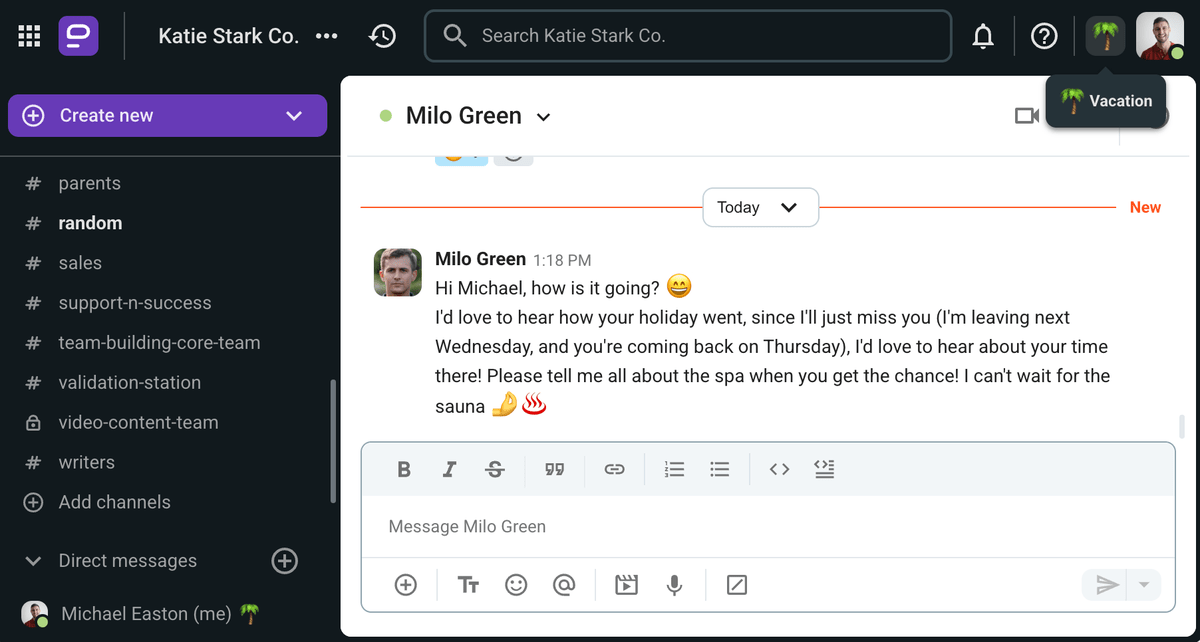
Connect with your team over Pumble
🎓 Pumble Pro Tip
If you’re having trouble deciding which method of communication to choose, our guide can help you decide what communication channel you should use in different situations:
Types of communication skills you should improve
Communication is usually classified into 4 types:
- Written communication,
- Verbal communication,
- Nonverbal communication, and
- Visual communication.
To be a successful communicator, you should constantly improve your communication skills in all 4 types of communication.
Our contributor, Kristie Stocker, adds a couple more types to the list:

“When most people think of communication skills, they think it’s how to talk to other people. That’s true to a point, but communication is a spectrum of modes: verbal, written, non-verbal, listening, and then there’s one-on-one conversations, public speaking, and impromptu speaking. There are some top skills you’ll want to excel at, but it really depends on your job role.”
Let’s go over the communication types.
Type #1: Written communication skills
Written communication involves the exchange of information, thoughts, and ideas through written language.
You’ll need written communication whenever you want to write an email, text, or message in the business messaging app. Furthermore, any document, report, or any other official written communication needs to be up to the standards of good written communication.
Written communication is one of the most used types of communication in the workplace. It enables us to send and receive messages in the time it takes to simply write or read an email.
Improving written communication skills is beneficial for the clarity, precision, and effectiveness of our written messages.
Here are a couple of pointers for good written communication, no matter the medium:
- Organize your thoughts and ideas before writing the message,
- Be concise and precise in your writing,
- Always use polite and professional language,
- Proofread everything before sending it.
Written communication highlights your ability to write clear and effective messages. It is an important aspect of your professional communication and should be improved upon constantly.
Type #2: Verbal communication skills
Verbal communication is any exchange of information that uses spoken language. It’s a dynamic form of communication that involves talking and listening skills. Improving verbal communication skills is essential if you want to engage in effective and impactful conversations.
Kristie Stocker believes that verbal communication skills are being neglected:

“In a land of emails and texts, this skill is falling by the wayside, and it shows in the current workplace. Many things simply can not be conveyed in a clear manner by email, especially emotion. People who can communicate verbally, state their message in a clear and simple manner, and tailor it depending on the person’s personality or needs are winning the communication game.”
You can enhance your verbal communication skills by:
- Practicing active listening,
- Using appropriate and clear language,
- Rehearsing your speeches,
- Building confidence, and
- Working on your vocal production.
Verbal communication skills are often regarded as something you were born with — you either have them or you don’t. However, if you put in the work and try to improve your skills consistently, you should be able to communicate confidently and eloquently in any given situation.
Type #3: Non-verbal communication skills
Nonverbal communication is the exchange of information without the use of words. It means you convey messages with the help of:
- Eye contact,
- Facial expressions,
- Gestures,
- Posture, and
- The tone of voice.
Nonverbal communication can add different layers of meaning to a conversation, even when it’s subconsciously done. That’s why you should always be mindful of your nonverbal cues and work on controlling your nonverbal communication patterns.
To keep the most important nonverbal cues in control, make sure to:
- Always sit up or stand up straight,
- Maintain an open posture,
- Maintain eye contact,
- Keep a smile on your face,
- Pay attention to the tone and volume of your voice, and
- Respect physical boundaries.
Much of nonverbal communication is subconscious. Therefore, it’s hard to control. However, paying attention to the most obvious nonverbal cues you’re sending can benefit your communication.
Type #4: Visual communication skills
Next up is visual communication — the process of conveying information through the use of visual elements, such as:
- Pictures and illustrations,
- Charts and graphs,
- Presentations, and
- Signs and symbols.
Visual communication is a practical way to share information that includes statistics, numbers, and other less digestible information.
In fact, research shows that visual elements are much easier to process than words. One study found that using color in business documents increases recall by 82%. It also increases comprehension by 73%.
Therefore, make use of visual elements when you can to enhance your communication.
What makes communication good?
Good communication is all about effective and meaningful exchange of information.
It entails being able to convey your thoughts and ideas clearly, while also being a good listener. Good communication creates a positive and respectful environment for open dialogue.
Successful communication has 3 elements:
- Effective sending of the message,
- Correct receiving of the message, and
- Mutual understanding and achievement of a common goal.
Communication can only be successful if all of these elements are included. Therefore, you should strive to be a good communicator in all 3 elements.
Element #1: Effective sending of the message
Effective sending of a message is the first step toward successful communication. It involves carefully crafting and delivering a message in a way that ensures clarity.
When sending a message, it’s important to consider the receiver, purpose, and desired outcome of the message. Then, according to that criteria, you can choose the appropriate language, type, and method of communication.
Effective sending of a message sets the stage for further communication and the achievement of the desired outcome.
🎓 Pumble Pro Tip
Check out our guide on effective communication to learn more about what it is and how you can improve it:
Element #2: Correct receiving of the message
The next element of successful communication is the correct receiving of the message. It involves actively listening to the other person, comprehending, and interpreting the message accurately.
To ensure you’re able to receive the message accurately, you should:
- Be an active listener,
- Focus on the conversation and limit distractions, and
- Clarify uncertainties to avoid errors.
You also need to be open to different perspectives and try to limit your preconceived notions or biases.
When you receive the intended message, you can respond appropriately and contribute to a productive conversation.
Element #3: Mutual understanding and achievement of a common goal
The end goal of successful communication is mutual understanding.
If you successfully communicate your message and correctly receive the other person’s message, you should be able to come to a mutual understanding.
In the workplace, successful communication also means achieving a common goal. For example, suppose your manager successfully communicates to you that you need to finish a certain task, and you actively listen and take in the information. In that case, the path is clear for the achievement of the goal.
However, if your manager failed to communicate their expectations or if you were busy doing other things instead of listening to instructions, you could run into problems.
That’s why communication is incredibly important in the workplace.
How to communicate effectively in the workplace?
Effective communication skills are essential for a productive and positive work environment.
The essential elements of effective communication can be summed up in the 7 Cs of communication, and they are:
- Clarity,
- Coherence,
- Confidence,
- Correctness,
- Conciseness,
- Concreteness, and
- Courtesy.
You can improve your communication skills by understanding the 7 elements of effective communication. We’ll describe them and give you some tips along the way.
Element #1: Clarity
You need to be a clear communicator in order to avoid misunderstandings and mistakes.
This simply means that you should:
- Focus on the idea and meaning of the message you want to convey — the main idea of your message should always be clear and obvious.
- Avoid jargon or unnecessarily complex language.
- Use concrete examples and provide clear instructions when necessary.
Expressing your thoughts clearly and succinctly will guarantee that your message will be correctly conveyed and understood.
Element #2: Coherence
Coherent communication is consistent and logical. The conversations flow smoothly and all the points are connected and relevant to the main topic of discussion.
To ensure you’re coherent in your communication, you should:
- Organize your thoughts and ideas before presenting them,
- Present your thoughts and ideas in a logical order, and
- Listen to the other person and respond accordingly.
When you’re coherent in your communication, your thoughts and ideas are more credible, and the other person can follow your train of thought. This will eliminate confusion, errors, and misunderstandings.
Element #3: Confidence
Confidence plays a major role in being able to communicate effectively. Confidence enhances your ability to express yourself clearly. It also conveys a sense of competence and self-assurance, which gives your ideas more credibility.
In the workplace, confidence is especially important. According to an Indeed survey, 98% of workers say they perform better when they feel confident. Moreover, 94% of the surveyed employees report feeling happier when they feel confident at work. Therefore, confidence is a skill worth building upon.
Being confident when communicating can help you appear more:
- Assertive,
- Persuasive, and
- Professional.
Furthermore, being confident can help you break down communication barriers such as:
- Fear and anxiety,
- Self-doubt, and
- Hesitation.
Without these barriers, you can express yourself and engage with others freely.
The survey also found that confidence reduces employee turnover. Namely, 96% of the surveyed employees say they are more likely to stay with a company when they feel confident.
Therefore, confidence is a skill beneficial not only for the individual but for organizations as a whole.
Element #4: Correctness
Correct communication means that there are no errors in communication. To be a correct communicator, you must always pay attention to:
- Grammar,
- Pronunciation, and
- Vocabulary.
When you use the correct language in your communication, you will appear more knowledgeable and credible. Correct communication also enhances your professionalism.
Furthermore, by being correct in your communication, you avoid misunderstandings and confusion as well as enhance comprehension.
There are a couple of ways you can ensure that your communication is correct, such as:
- Proofread every message before sending it,
- Double-check if the data you are sending is correct (especially names and numbers),
- Consult grammar checkers and spell checkers if you have doubts, and
- Think about what you want to say before you say it.
Correct communication not only prevents errors but also shows that you respect your interlocutor.
Element #5: Conciseness
Conciseness is a valued attribute in the professional world. Everyone appreciates it when you’re concise, as it saves a lot of time. Conciseness means that you communicate your message in the fewest words possible.
To communicate concisely, you should:
- Leave out redundant words (“really”, “very”, “maybe”, etc.),
- Leave out filler words in oral communication (“umm”, “like”, “I mean”, “well”, etc.),
- Use simple sentences, and
- Stick to one topic at a time.
In addition to saving time, concise communication also:
- Makes the message clearer for the listener/reader and
- Highlights your main points better.
Element #6: Concreteness
Concrete communication helps the listener understand exactly what you’re trying to say. It enables you to present information in a specific and vivid way.
To uphold concreteness in your communication, you’ll need to:
- Use specific and clear language,
- Avoid generalizations,
- Provide specific instructions,
- Use precise modifiers, and
- Support your views with facts and evidence.
When you’re concrete in your communication, it helps you:
- Avoid misunderstandings,
- Give credibility to your words, and
- Speed up the work in the team.
Element #7: Courtesy
Last but not least, always be courteous in your communication.
Courtesy simply means that you treat people respectfully. Even in challenging situations, being courteous in your communication goes a long way.
When you show courtesy and treat everyone with respect, you will:
- Create a healthy and productive team,
- Build positive interpersonal relationships, and
- Keep team members feeling appreciated and valued.
Treating everyone with respect is the basis of courtesy, but you should also:
- Be polite and professional,
- Be open to different views and opinions,
- Think about the needs of others, and
- Be honest and open in your communication.
How to improve communication skills in the workplace?
Now that we’ve covered the elements of effective communication, let’s take a look at some practical tips on how you can improve your communication skills in the workplace.
Our contributor Chuck Wisner believes that communication skills need to be practiced:

“The skills noted above take practice. We adopt our communication patterns from our families, education, and experiences. Better communication skills require self-awareness, emotional intelligence, and trial-and-error experiments. Changing our patterns requires us to be less judgmental of ourselves and others.”
Here are some tips that will help you improve your communication skills and, if needed, change your previous communication patterns.
Tip #1: Be concise and clear
The pillars of professional communication are efficiency and clarity. Therefore, you should always remember to keep your communication concise and straightforward.
Kristie Stocker says that you can never be too clear:

“When I speak to companies about communication skills, I remind them there’s no such thing as TOO clear. That doesn’t mean piling on hundreds of details, but making your message clear and to the point without a lot of rhetoric. Being clear about expectations, feelings, thoughts, insights and everything in between is a key to better understanding for everyone.”
Therefore, keep conciseness and clarity in your mind at all times.
Tip #2: Ask for, accept, and give feedback
Feedback is an integral part of professional development, as it gives you the opportunity to improve your skills and thrive in your career.
One survey found that 23% of employees are unsatisfied with the frequency of feedback coming from their direct manager.
Stocker proposes a couple of questions you can ask to prompt feedback:

“Seek feedback.
‘Was I clear enough on that?’
‘Did that make sense?’
‘What do you think was the main point of what I discussed?’
‘Was there anything else you wanted me to hear?’
Listen to what others say and change what you feel necessary. You may have thought you were 100% clear, but to the people giving you feedback, something was missed.”
Therefore, don’t hesitate to ask for feedback, and always remain open to hearing feedback from others.
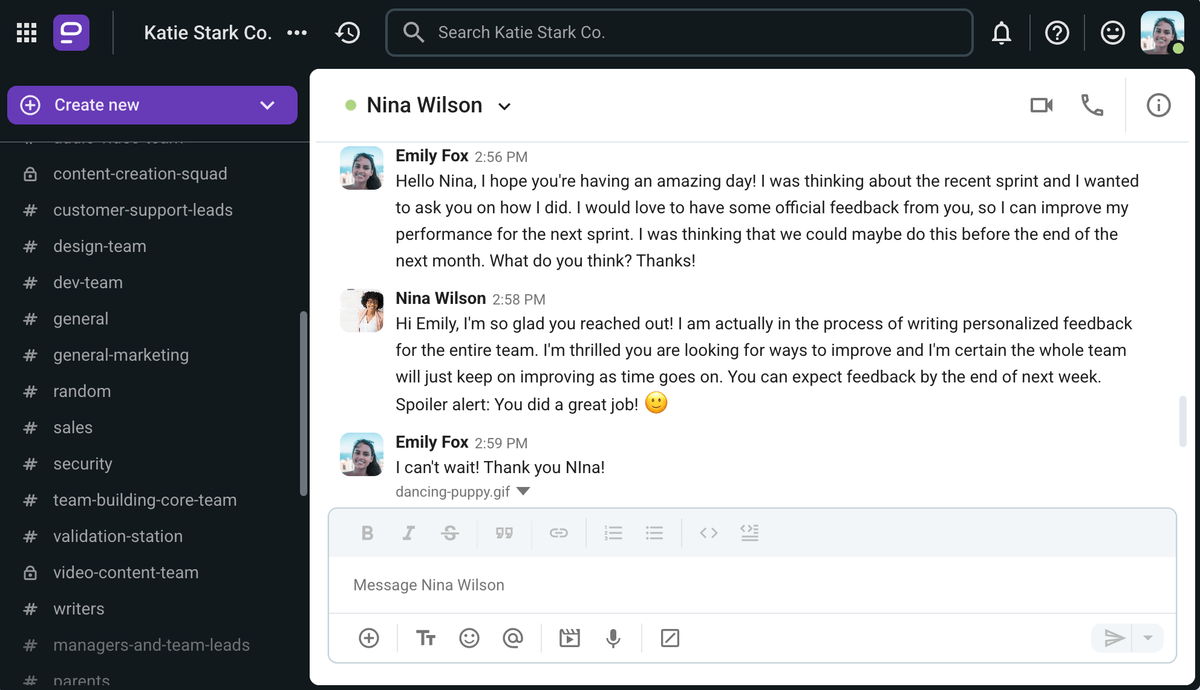
Use Pumble to seamlessly share feedback
🎓 Pumble Pro Tip
If you’re interested in the difference between feedback and feedforward and want to learn more about it, read our blog post:
Tip #3: Be respectful of other people’s time
Whether you’re engaging in small talk in the office or on a video call with your manager, remember that their time is valuable.
Keep your communication concise and to the point.
- Don’t hang around for too long at someone’s desk in the office.
- In a meeting, make sure to get to the point quickly and stick to the agenda of the meeting.
- In a team communication app, feel free to chat with team members, but remember to respect their personal time and don’t message them after working hours.
In any type of communication, take the other person into account and respect their time.
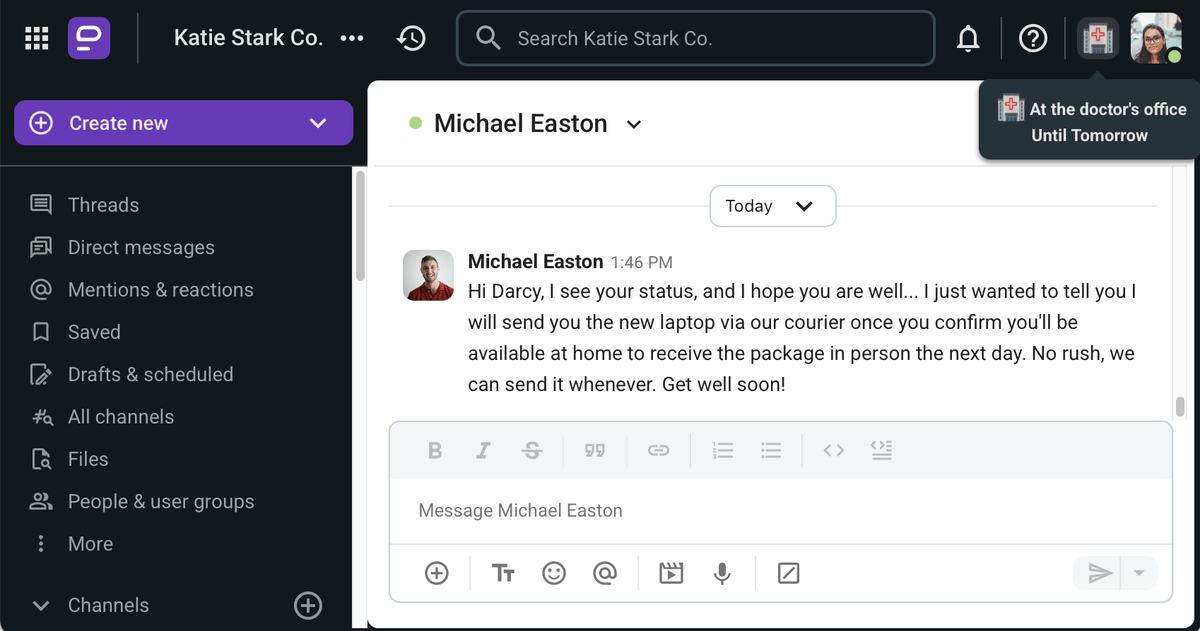
Tip #4: Prepare what you’re going to say
Improving your verbal communication skills can be challenging, especially if you deal with stage fright or meeting anxiety.
In stressful situations, it’s best to be prepared. If you have a presentation coming up, but you’re anxious to speak in front of others, don’t hesitate to practice. Prepare exactly what you are going to say and rehearse it until you feel comfortable and confident.
Whether you’re comfortable with public speaking or not, you will benefit from practicing your presentations beforehand.
Practicing your speeches will give you an opportunity to detect weak points in your presentations and in your delivery.
Additionally, many people struggle with anxiety over difficult conversations they need to have with team members. These can include asking for help, giving feedback, or discussing money.
In any situation, it’s best to plan ahead and prepare for any potential questions, disagreements, or requests for additional information. By being prepared, you can address these in a calm and constructive manner.
Planning ahead is the best way to decrease stress and anxiety and improve communication.
Tip #5: Be ready for unexpected answers
A key trait of an active listener and a successful communicator is listening without judgment.
Put yourself in the other person’s shoes and think about their perspective. Listen without interrupting, and make sure to keep your preconceived notions and biases in check.
Also, be prepared to hear negative information or feedback, and you will be ready to accept or refute the opposing views.
Tip #6: Eliminate conversation fillers and non-words
Another tip for better verbal communication is to eliminate filler and non-words.
You can drastically improve your oral communication if you become friends with pauses. Pauses in your speech can help you gather your thoughts and catch your breath. This eliminates the need for conversation fillers and non-words.
Conversational fillers are also known as vocal disfluencies or hesitations. Words such as “like”, “right” and “so” are the most common fillers. There are also filler phrases, such as:
- “In my opinion”,
- “Needless to say”,
- “You know”, and
- “Well, basically”.
Non-words are filler sounds that hold no meaning, such as:
- “Um”,
- “Ah”, and
- “Hmm”.
There are a couple of things you should do if you want to eliminate filler words and sounds from your speech:
- Practice your speech and listen to yourself,
- Pause and embrace the silence between thoughts,
- Speak slowly and clearly, and
- Use shorter sentences.
It’s not easy to completely eliminate filler words and sounds from your speech, but with a bit of practice, you can lower the frequency of them occurring.
Tip #7: Ask questions
To make sure you understand what’s being said, don’t be afraid to ask questions.
Asking questions will also show that you’re engaged and actively listening to the other person.
Make sure to ask open-ended questions to elicit meaningful responses and further the conversation.
This will make the speaker:
- Clarify their opinions,
- Consider other points of view, or
- Think even deeper about the subject.
Kristie Stocker believes in the power of asking yourself questions while listening in order to contribute to the conversation. Here are some of the questions she finds useful:

“What are they actually saying?
What’s their point?
Is there an important message behind what they’re saying I should take into consideration?
Those are some starter questions to ask yourself when listening.”
Asking the right questions is the catalyst for good conversations, so ask away.
Tip #8: Avoid distractions
Avoiding distractions should be a priority, whether you’re talking to someone in person or chatting via an internal communication app.
- Try to be present in the conversation, and limit any possible interruptions, such as your phone or laptop.
- If you’re in an important meeting, turn off your notifications.
- In the office, put your phone away when you’re talking to a team member.
Kristie Stocker agrees that distractions are harmful to our communication:

“When communicating with someone, they should be the most important person in the room. I’ve noticed in this society, people are ignoring the human in front of them and giving their energy to an electronic device (aka distraction!). My biggest tip, if you want someone to feel heard, look at them when they speak. You can ‘say’ you’re listening to them, but looking at your phone or the TV, or anywhere else while they’re talking is just plain rude. They won’t feel important, they’ll feel less valued and that feeling can spread.”
Give your full attention to the other person to showcase your respect and contribute to a meaningful conversation.
Tip #9: Utilize communication tools
Communication tools are software or hardware that allow teams to communicate and collaborate. Communication tools, such as team communication apps, can help teams connect faster and easier, especially in a remote work environment.
Our contributor, Smita Das Jain, believes that it’s important to be flexible and open to using new technology:

“With the increasing use of digital communication tools, it’s important to be adaptable and proficient in using technology effectively. Learn to use various platforms, tools, and channels to communicate efficiently.”
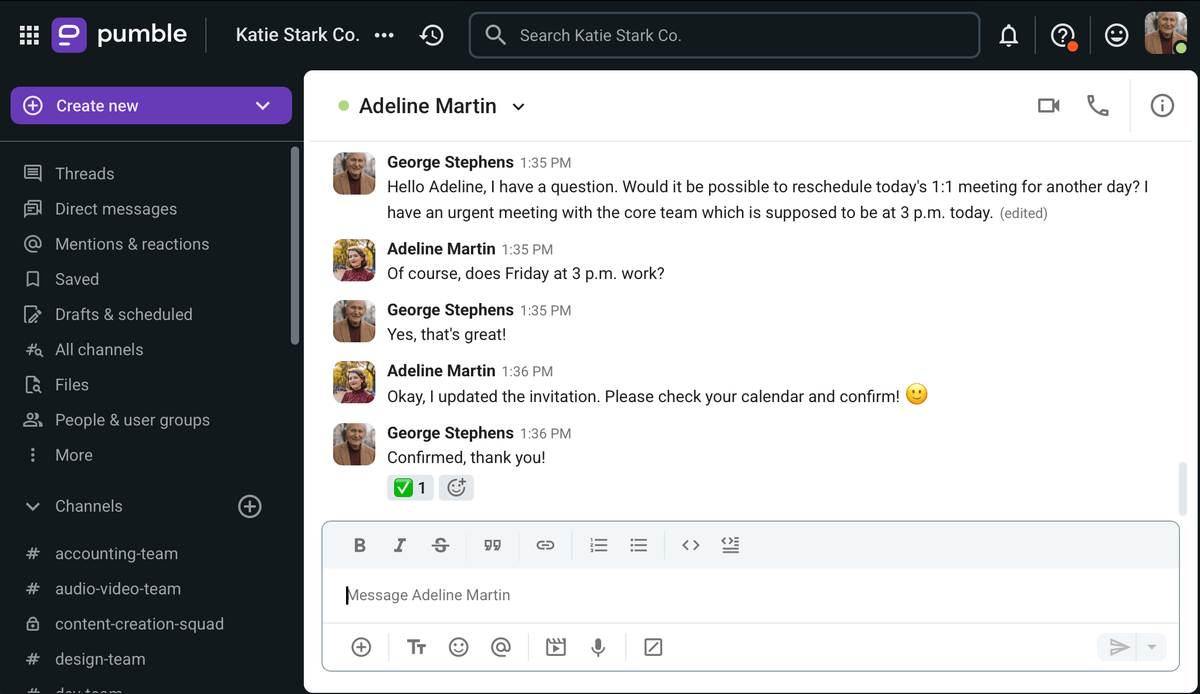
Tip #10: Self-reflect
To start improving your communication skills, you first need to take a look at the current state of things. Assess your strengths and weaknesses and identify areas that need improvement.
Wisner also agrees that self-reflection is the key to improving your communication skills:

“Start improving your communication skills by noticing your personal patterns. What people or types of interactions trigger your defensive reactions? What is your pattern around advocating and defending your opinions? What are your patterns around listening? Begin to note how you ask questions. Are they sincere? Are they accusatory? Are you open to learning something new?”
When you’ve identified which skills need improving, you can start implementing our tips and strategies for better communication.
🎓 Pumble Pro Tip
Looking for more communication strategies for improved team collaboration? Check out our article on the topic:
Why are good communication skills important?
Great communication skills are beneficial in many ways. Namely, good communication positively affects:
- Employee happiness and well-being,
- Employee engagement,
- Productivity,
- Employee retention, and
- Financial health of companies.
In Chuck Wisner’s experience, effective communication skills are vital for productive teams:

“Conversations are the one tool we share to get stuff done. In my work over the last 30 years, I have watched individuals and teams get stuck because they needed to learn how to talk, listen, and interact more skillfully.
No matter the kind of work we do, it is our shared ability and responsibility to have mindful conversations. More conscious conversations result in getting smart with others, creating ideas, and making wiser decisions.”
Let’s go over the benefits of good communication in more detail.
Benefit #1: Good communication makes employees happier
Good communication in the workplace is a strong predictor of employee happiness and well-being.
According to a literature review on the link between communication and employee happiness, open channels of communication are a major driver of employee happiness. Research has shown that open communication in all directions is important. Namely, downward communication is as crucial as upward and lateral communication.
Furthermore, according to the Connected Culture Report, employees in teams that value connection cite better physical and emotional well-being.
Fostering good communication in the workplace creates an environment where employees feel connected and informed, making them happier and healthier.
Benefit #2: Good communication increases productivity
Connected teams also report higher productivity.
According to The State of Business Communication report, 72% of business leaders believe that effective communication has increased the productivity of their teams. The same study also found that effective communication positively affects employee confidence, which increases productivity.
Therefore, if you want your business to thrive and your employees to be productive, make good communication a priority.
Benefit #3: Good communication increases engagement
Disengaged employees cost the world $8.8 trillion dollars in lost productivity, according to Gallup’s State of the Global Workplace report.
At the core of the issue is a lack of communication that leads to disengaged employees.
Firstly, companies are failing to communicate their values and strategies to their employees. That’s a missed opportunity for employees to feel connected to the organization at a deeper level.
Furthermore, with the rise of remote work, remote employees tend to feel even more disengaged. Here, companies are failing to open various channels of communication to ensure their remote employees feel included.
The Gallup report found that only 23% of workers worldwide are engaged. To change this, good communication practices need to be at the forefront of every company’s values.
🎓 Pumble Pro Tip
If you’re interested in taking a deeper look into employee engagement statistics and the cost of poor engagement, check out our guide:
Benefit #4: Good communication increases employee retention
As we’ve covered, good communication increases employee engagement, which affects productivity — Lattice’s 2025 State of People Strategy report found that 56% of high-performing teams come from companies that prioritize engagement.
All of this affects employee retention as well, as engaged employees that perform well are less likely to leave their company.
So, to put it simply, good communication leads to employee engagement, and engagement leads to employee retention.
Benefit #5: Good communication saves money
A consequence of poor communication is lost money.
Namely, 38% of business leaders have noticed a financial impact of poor communication, according to the previously mentioned State of Business Communication 2023 report. Furthermore, the report estimates that poor communication costs US companies $1.2 trillion dollars a year.
A report from Axios HQ, which surveyed 540 business leaders and over 1,000 employees, estimates that poor communication costs US companies upwards of $2 trillion dollars a year.
It’s evident that a lack of communication skills is detrimental to the success of organizations. Developing and nurturing good communication skills is an investment that pays off.
Examples of good communication skills
Now that you know everything about communication skills, let’s take a look at a few examples of good communication in the workplace.
Example #1: Clear communication and honesty
In this example, the manager, Nina, is reaching out to Adeline via their employee communication app, Pumble, to get an update on a project. Adeline has encountered some difficulties on the way.
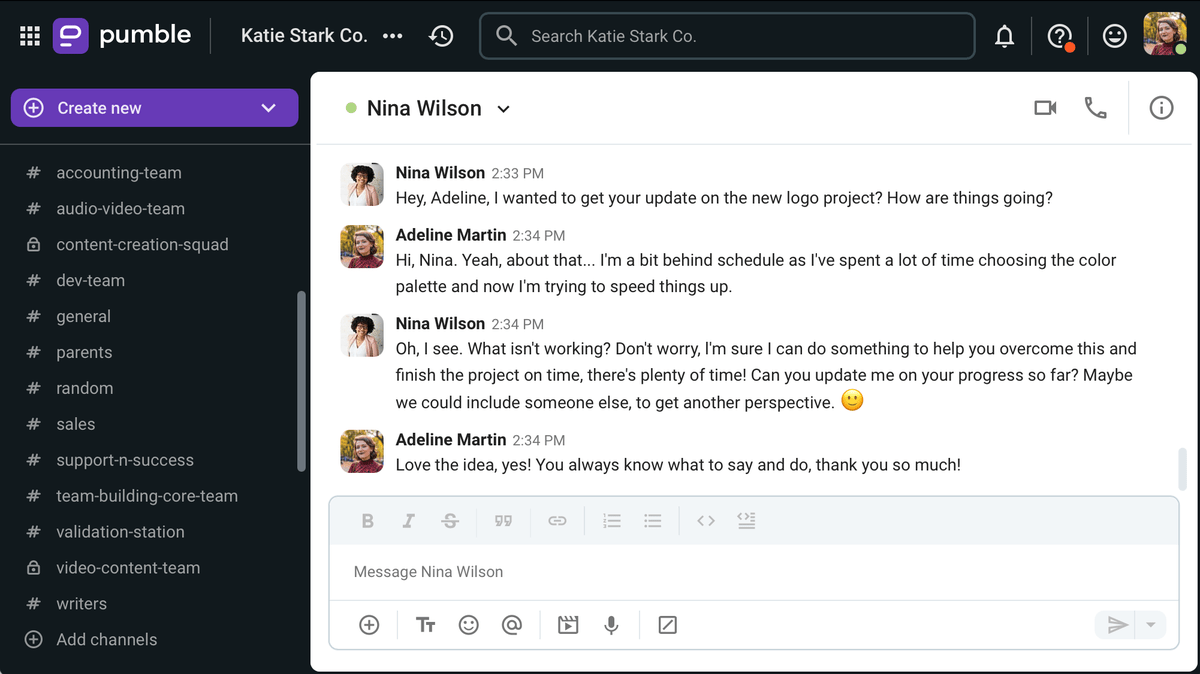
Promote effective team communication with Pumble
This conversation showcases great communication skills from both parties. Firstly, as the manager, Nina has taken on the responsibility of reaching out to Adeline to check in. She gets straight to the point with a clear and concise message asking for an update.
Adeline responds honestly and admits that she’s having difficulty staying on schedule.
Nina then demonstrates emotional intelligence in her next message. She empathizes with Adeline and provides words of support. Nina also offers a clear solution to fix the situation. She does all this while maintaining a friendly and positive attitude towards Adeline.
Adeline finishes with a polite and professional message that conveys mutual understanding.
Example #2: Open communication and empathy
In the next example, we have a conversation between a manager and a team member. The manager Jessica has noticed a change in Darcy’s performance and wants to know if she’s all right.
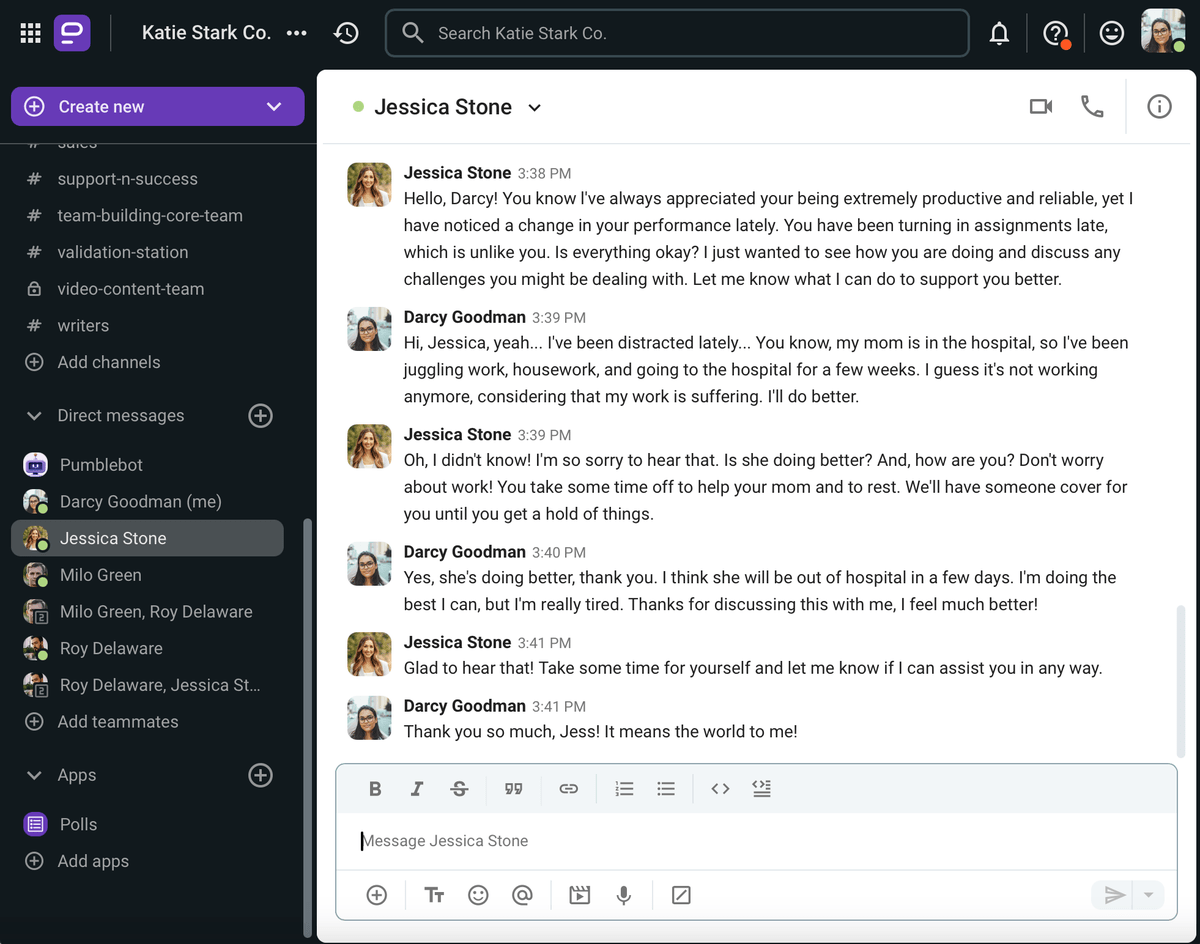
Here we can clearly see many different skills for good communication. Firstly, Jessica demonstrates an empathetic attitude with genuine questions about Darcy’s well-being. She also approaches the subject in a positive manner by complimenting Darcy’s past work before pointing out the recent changes in her performance.
Darcy is open and honest with Jessica and concisely lets her know that she’s been struggling. Darcy also demonstrates her immediate willingness to accept feedback.
Jessica then empathizes with Darcy and offers clear solutions.
The conversation flows coherently, and both Jessica and Darcy feel better at the end of it.
Example #3: Friendliness and concreteness
In this example, a product design team is discussing the color scheme for a product. Even though multiple team members are communicating, the conversation flows coherently, and they reach a mutual understanding.

Darcy and Roy demonstrate a friendly and positive attitude in this group chat by complimenting the team’s choices.
John asks a few questions to deepen the conversation and try to approach the subject from different angles.
Emily responds in a thoughtful way and answers John’s bid for further consideration. She also displays a friendly attitude by acknowledging that John is a new addition to the team.
John then concludes the conversation with a concrete answer — complete with research data. This gives credibility to his words.
Example #4: When communication goes wrong
In this example, 3 team members are trying to reach a common agreement. However, one team member is frustrated and gives up on trying to come to a compromise.
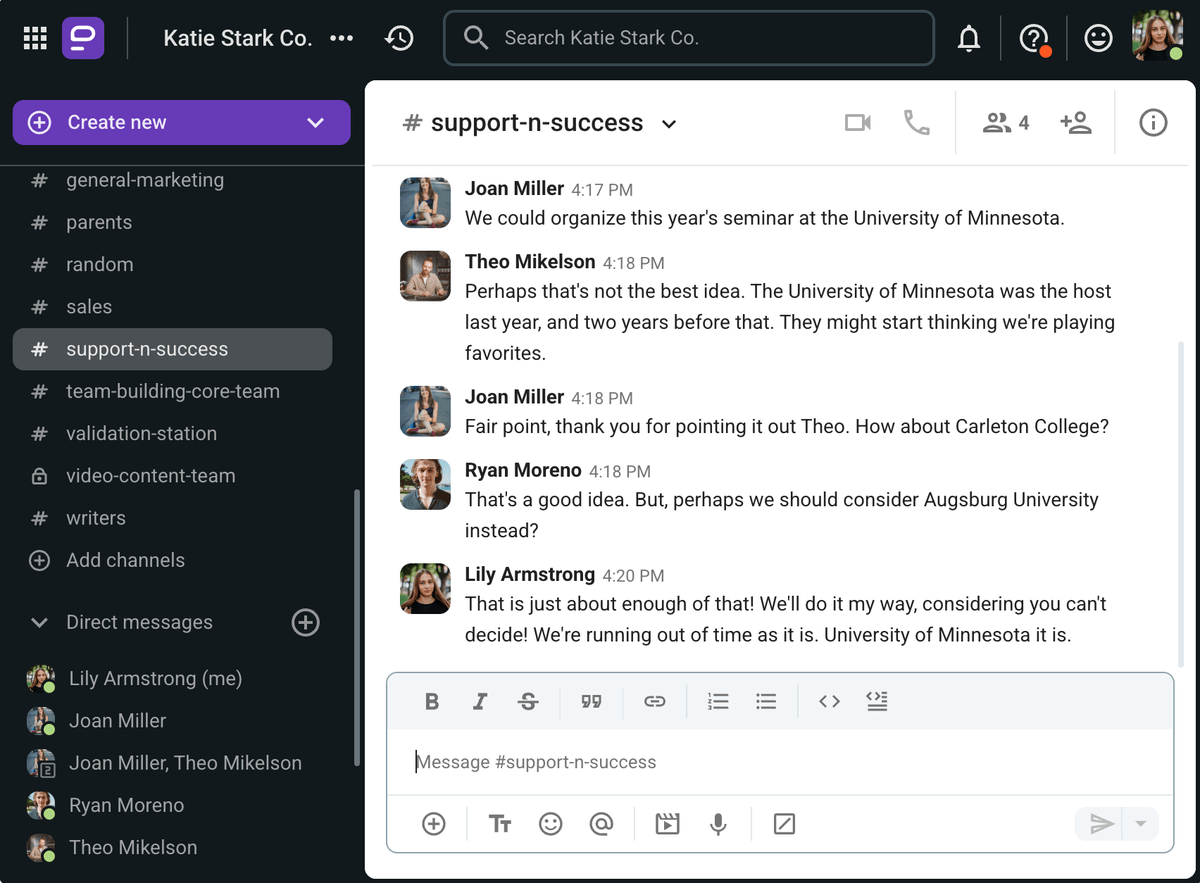
Joan, Theo, and Ryan are trying to devise a solution that will work for everyone. They demonstrate professionalism and clarity. Theo is also confident in his suggestions for a better solution.
They are all concise, coherent, and engaged in the conversation.
However, Lily becomes frustrated with the process of deciding on the best solution and cuts the conversation short. She imposes her opinions on the team and stops any further discussion. Although she is undoubtedly clear in her communication, the delivery of her message is rude and unprofessional.
Improving your communication skills with Pumble
The communication process can get complicated quickly in any workplace. This is why it’s important to streamline your communication and organize it in a way that’s easy to understand and learn.
Using team communication platforms like Pumble can help you completely transform communication in the workplace. Pumble is a straightforward and versatile digital HQ that allows the entire team to be updated on all the relevant info all of the time.
Pumble’s main features include:
- Direct messages — for keeping track of important information,
- Channels — for organizing team members and information in dedicated spaces,
- Video conferencing — for improving nonverbal communication in face-to-face meetings, and
- Custom notifications — for creating personalized communication boundaries.
Your digital communication hub is the ideal place to nurture correctness, conciseness, confidence, and clarity.
Develop the most important communication skills and never miss a beat — make a free Pumble account today!
How we reviewed this post: Our writers & editors monitor the posts and update them when new information becomes available, to keep them fresh and relevant.

